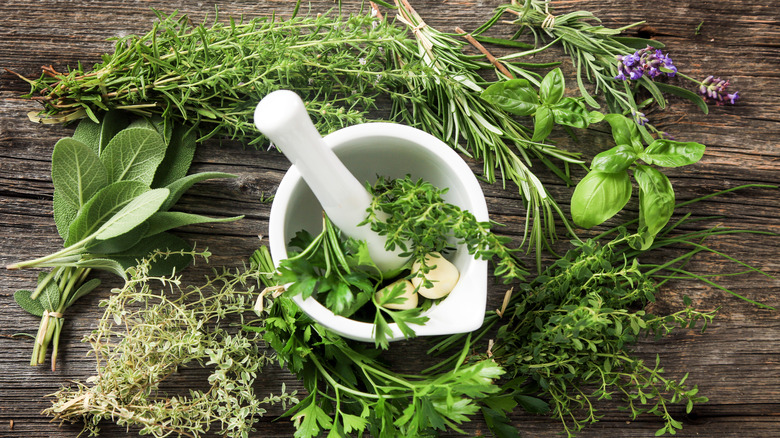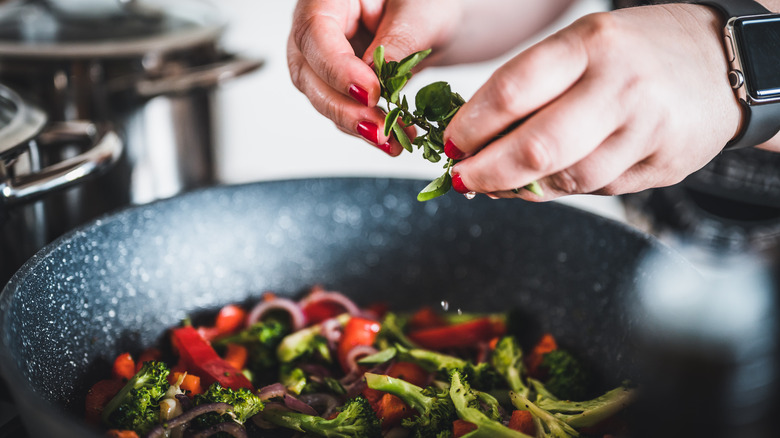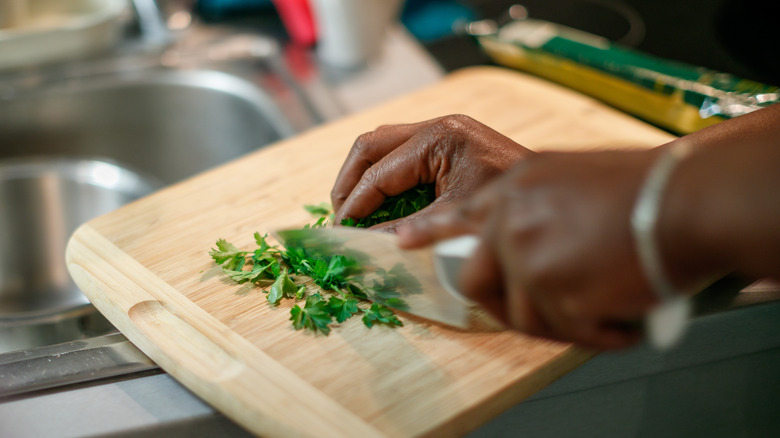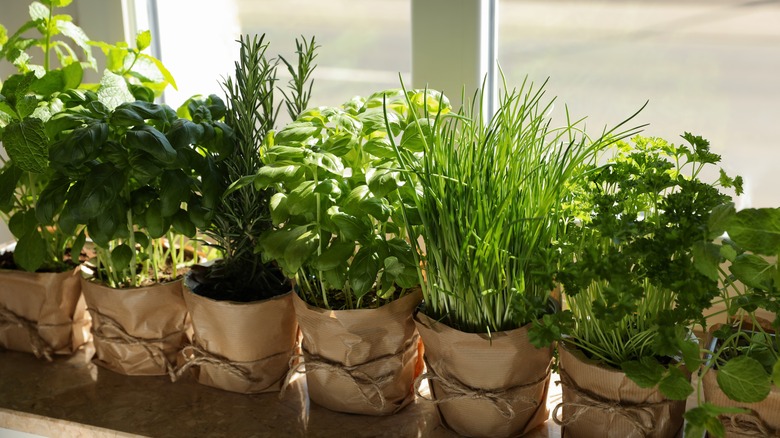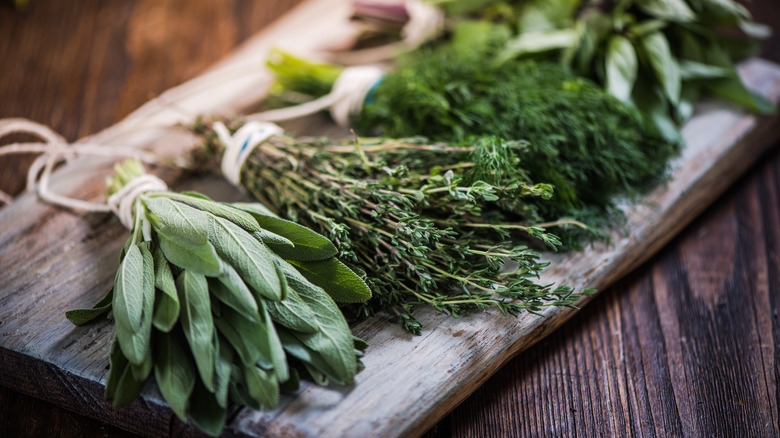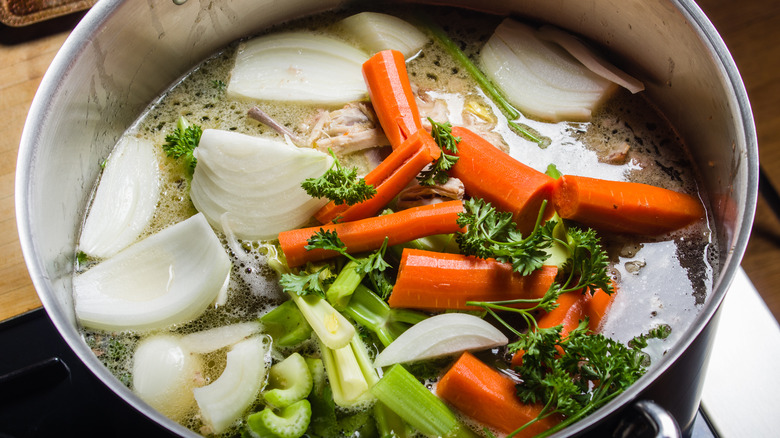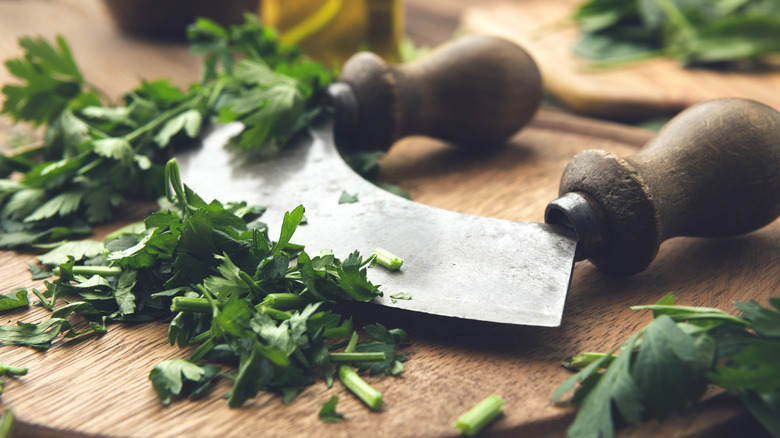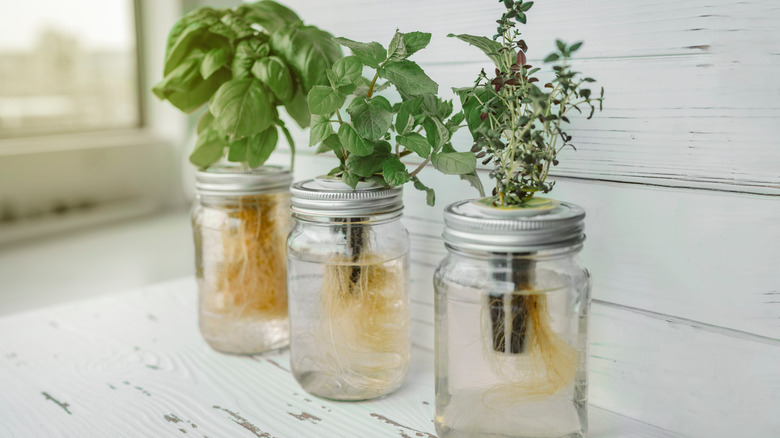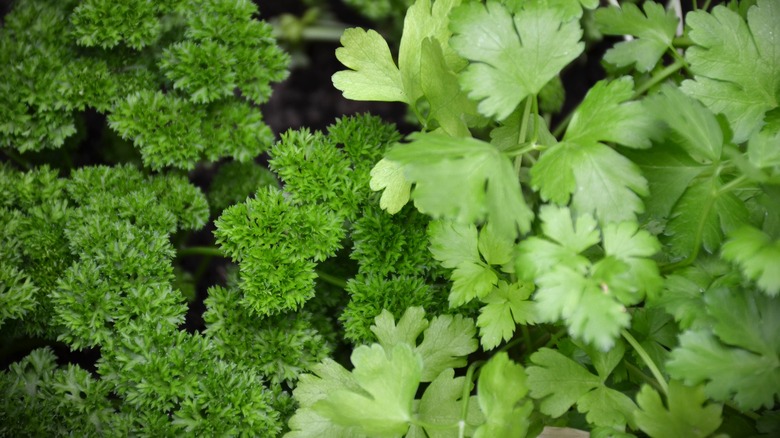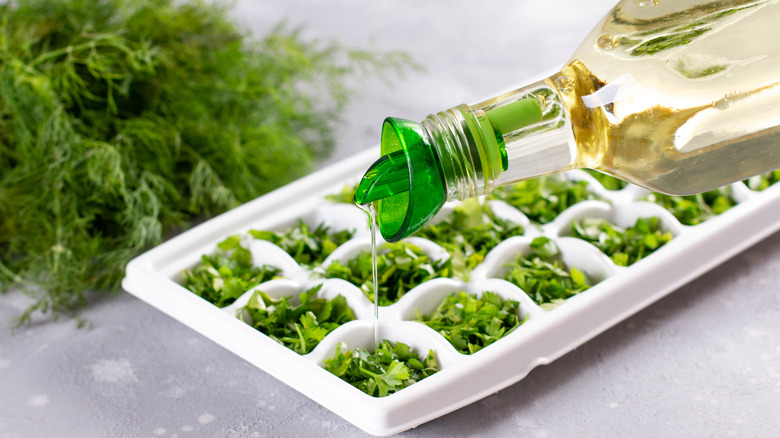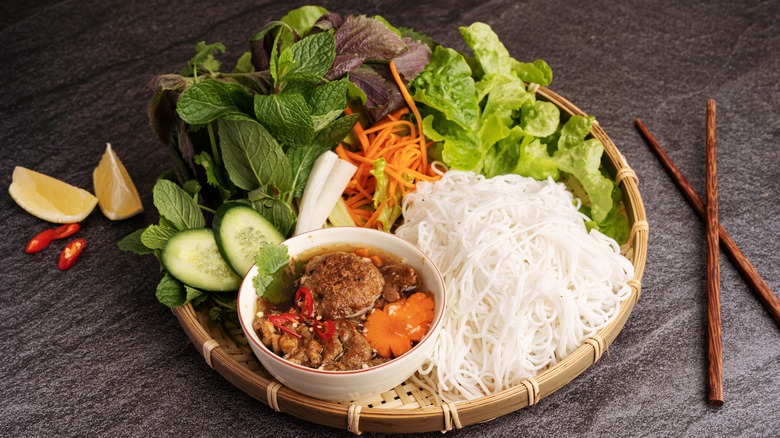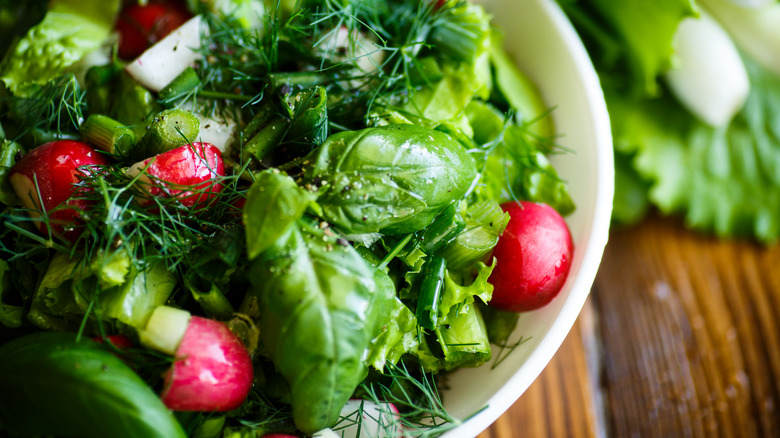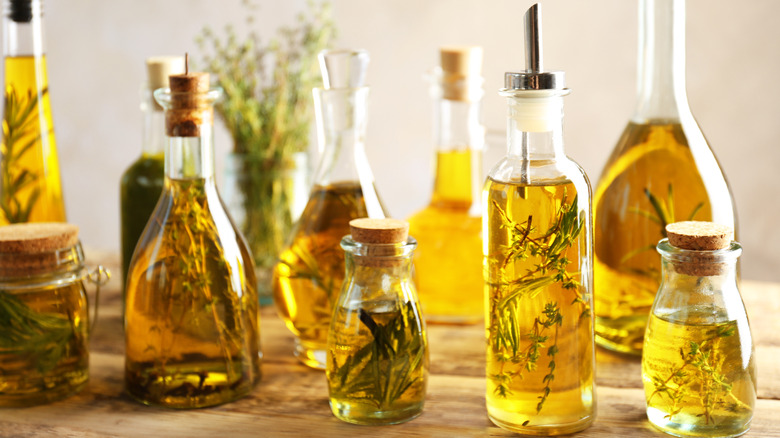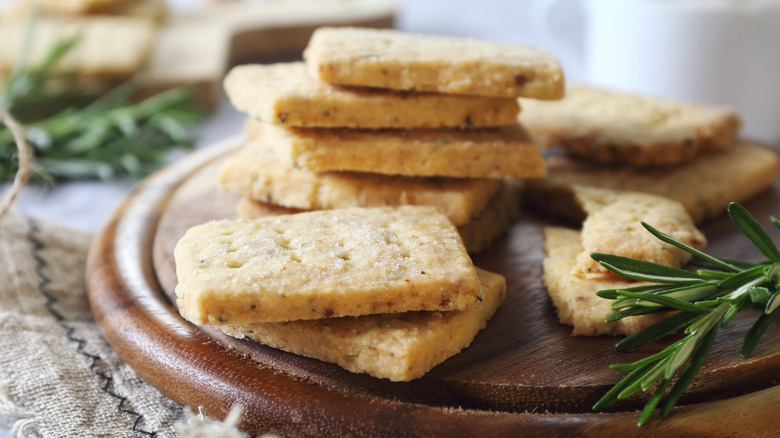Mistakes Everyone Makes When Cooking With Fresh Herbs
Fresh herbs can transform a humdrum dish into something special. Whether you're a seasoned chef or a novice in the kitchen, there's no denying the allure of adding a handful of fresh basil to a tomato salad or sprinkling some chopped cilantro over a bowl of chili. Their bold, bright flavor adds something special, but all of us make mistakes when cooking with fresh herbs.
We'll uncover some of the most common mistakes — such as adding them too early and using the wrong tools to chop them — and touch on how to fix them. Before you know it, you'll embrace fresh herbs with full confidence, adding them to all kinds of dishes, from soups and stews to salads and sandwiches. There are no limits to what you can do with herbs when you know how — you can even add them to sweet recipes.
You might not even realize you're making mistakes until you learn the right way to use them, and then you'll wish you'd been doing it that way all along. So, whether you're growing herbs in your garden or picking them up from the local market, read on to discover how to avoid these culinary slip-ups, and unlock the true essence of fresh herbs in your dishes.
Adding them to dishes too early
One of the most common mistakes people make when cooking with fresh herbs is adding them to dishes too early in the cooking process. The delicate oils and compounds in herbs are highly susceptible to heat, and can easily evaporate or break down when exposed to prolonged cooking. This can lead to a loss of flavor and aroma when herbs are added too early. However, with a few simple adjustments, you can ensure that your dishes are bursting with the full, vibrant flavors of fresh herbs.
When herbs are added too early, they are subjected to extended exposure to high temperatures, causing their essential oils and aromatic compounds to dissipate. This results in a milder and less impactful herb flavor in the final dish. To avoid this, consider adding herbs towards the end of cooking. When you incorporate them into your dishes during the last few minutes, it allows the herbs to impart their flavors without being subjected to prolonged heat.
You can also sprinkle freshly chopped herbs as a garnish just before serving your dish. This not only ensures that the herbs maintain their vibrant color and aroma, but also provides a burst of fresh flavor with each bite. Or, if a recipe calls for herbs to be added early for a milder flavor and late for a burst of freshness, don't hesitate to use the same herb at both stages. This way, you get a more nuanced herb profile.
Not knowing how much to use
Another frequent mistake when cooking with fresh herbs is not knowing how much to use. Fresh herbs have the power to enhance the flavors of your dishes, but if you use too little, you'll end up with a dish that isn't flavorful enough, while using too much can be overpowering. Fortunately, there are practical ways to determine the right amount of fresh herbs to use and ensure your dishes are perfectly seasoned.
When you're new to using fresh herbs, recipes can be your best friend. They often provide specific measurements for herbs, which serve as a great starting point. As you gain more experience, you can adjust according to your personal taste preferences. Different herbs have varying levels of potency. For instance, rosemary and thyme are robust and can be used sparingly, while basil and cilantro are milder and can be used more generously. Understanding the intensity of each herb will help you gauge how much to use.
Sometimes you might be using fresh herbs in a recipe that usually uses dried herbs. In this case, it's important to know what ratio to use. For every teaspoon of dried herbs a recipe calls for, you should use 3 teaspoons (or 1 tablespoon) of chopped fresh herbs.
Being unaware of differences between tender and woody herbs
Tender herbs and woody herbs — also known as soft herbs and hard herbs — are two broad categories of herbs that differ primarily in their texture, flavor, and culinary uses. Understanding the distinctions between these two types of herbs is essential for successful herb-based cooking.
Tender herbs have soft, delicate stems and leaves. They are typically more pliable and easy to chop or tear. They often have a milder, more delicate flavor than woody herbs. They're often characterized by their fresh, grassy, and sometimes slightly sweet or peppery notes. Examples of tender herbs include basil, cilantro, parsley, mint, dill, and chives.
Woody herbs, on the other hand, have sturdy, woody stems and tougher leaves. You usually don't eat these stems, so you remove the leaves from the stems before cooking with them. Woody herbs have a stronger, more robust flavor compared to tender herbs. They often have earthy, resinous, or slightly bitter notes that can add depth to dishes. Examples of woody herbs include rosemary, thyme, and oregano.
Not knowing which herbs to use when
Knowing which herbs to use in which dishes can really elevate your cooking when you're freestyling in the kitchen rather than following a recipe. Herbs come in a dazzling array of flavors, and the wrong choice can lead to a dish that lacks harmony or balance. Fortunately, with a bit of guidance and experimentation, anyone can learn to match the right herbs with the right dishes. Using the wrong herbs in a recipe can result in flavors that clash or overpower the other ingredients, leading to a less-than-satisfactory culinary experience. For instance, using herbs like rosemary and thyme in a Thai-inspired curry wouldn't match the flavor profile or the rest of the ingredients. Conversely, using mild herbs like parsley in a hearty stew might result in a dish that lacks depth and complexity.
So, how do you fix it? Start by getting to know the flavor profiles of different herbs. For example, basil is sweet and slightly peppery, while cilantro has fresh, citrusy notes. Understanding these basic characteristics will help you make better choices. Some herb combinations have stood the test of time for a reason. Try classic pairings like basil and tomatoes, or rosemary and potatoes to discover how these flavors harmonize. Then, you should think about which herbs are traditionally used in foods from around the world. Different cuisines often have their preferred herbs. For example, Italian cuisine frequently uses basil and oregano, while Thai dishes often feature cilantro and lemongrass.
Discarding herb stems
Many home cooks diligently pluck the leaves from herb stems, discarding the latter as waste. So, if you're discarding herb stems without realizing their culinary potential, you're not alone. Often overlooked and underestimated, herb stems can be a valuable addition to your cooking repertoire, adding depth of flavor and reducing food waste.
Herb stems, when simmered in stocks, broths, and sauces, can infuse them with subtle herbaceous notes. Simply add the stems to your liquid and remove them once the desired flavor is achieved. This works for both woody and soft herb stems. You can also use both tender and woody herb stems to create flavorful herb-infused oils and vinegars. Place the stems in a clean, dry container and cover them with oil or vinegar. Let them steep overnight to extract the herb essence. Then, with tender herbs, you can chop or blend the stems into a wide range of dishes. They're especially great in herb-heavy sauces and dressings, such as pesto and chimichurri.
Not using the best tools when chopping them
If you're struggling while chopping your herbs with a knife, you really need to look into other tools that will make the process easier. Not only will chopping herbs take more time, but you might end up with unevenly chopped herbs, leading to inconsistent flavors and an unpleasant texture in your dishes. Fortunately, there are effective solutions to this issue, such as employing kitchen shears or a mezzaluna, that can help you achieve finely chopped herbs with ease and precision.
Kitchen shears are an excellent tool for chopping fresh herbs efficiently. Their sharp blades can easily cut through herbs with precision, allowing you to achieve the desired texture without damaging the delicate leaves. Alternatively, there's the mezzaluna, which means "half-moon" in Italian. This is a specialized herb-chopping tool consisting of a curved blade with two handles. It excels at finely mincing herbs and is a favored choice in professional kitchens. To use it, you simply place the herbs on a cutting board, and hold the mezzaluna by its handles. Then you rock the blade back and forth over the herbs until the herbs are chopped to your desired consistency.
Not storing them correctly
Many people buy fresh herbs with good intentions but then neglect proper storage, causing them to deteriorate quickly. Herbs are delicate and require specific conditions to stay fresh and flavorful. If you store fresh herbs correctly, they can last for as long as 3 weeks, while incorrectly stored herbs might only last a few days.
So, how should you store them? This really depends on the type of herb. However, for all herbs, you should start by washing and drying them thoroughly. If you have woody herbs — like rosemary or thyme — wrap them loosely in a damp paper towel, and place them in a plastic bag or an airtight container in the fridge to maintain moisture without becoming too wet.
For soft herbs, like basil or cilantro, with their stems intact, the best way to store them is upright in a glass of water, like a bouquet of flowers. Cover them loosely with a plastic bag and change the water regularly. All tender herbs should be stored this way in the fridge, except basil, which prefers to stay at room temperature. Your herbs will also last longer if you know what to look for when buying them. Fresh herbs should have vibrant, colorful leaves or stems. Avoid herbs with yellowing or wilted parts. They should also have a strong aroma. If the herbs are odorless or have a musty smell, they may be past their prime.
Thinking there's no difference between flat and curly parsley
Think that all parsley is essentially the same? Well, you're sorely mistaken, but you're not alone. Many people don't know the nuances of the difference between flat and curly parsley, but there is an important distinction.
Flat-leaf parsley is sometimes also known as Italian parsley. It has a more robust, assertive flavor compared to curly-leaf parsley. It boasts a slightly peppery, earthy, celery-like taste with hints of citrus, making it an excellent choice for dishes where the parsley flavor should be more pronounced. It's also softer and more tender than curly parsley. Many chefs consider it the superior type of parsley.
Curly-leaf parsley has a milder, more delicate flavor and is slightly grassier in taste. It is often used as a garnish because it doesn't overpower other flavors, providing a fresh and crisp finishing touch. It also has a tougher texture, which can make it unpleasant in certain dishes. By recognizing the differences in flavor and texture between flat-leaf and curly-leaf parsley, you can make more informed choices when selecting the right variety for your recipes.
Failing to freeze leftover herbs
It's not uncommon to buy more herbs than you need. That's to be expected, but the mistake is not freezing leftover herbs and just letting them go bad instead. Fresh herbs have a relatively short shelf life, and when you purchase more than you need for a single recipe, it's essential to preserve their freshness for later use.
One effective method to preserve leftover herbs is to chop them finely, place them in an ice cube tray, fill each cube with oil, and freeze. Once frozen, transfer the herb cubes to a sealed bag or container. This allows you to conveniently add herb flavor to soups, stews, sauces, and other dishes whenever needed.
You can also use a blender to whizz up herbs and olive oil before freezing the mixture in ice cube trays. These herb-infused oil cubes can be used to add flavor to various recipes, including sautés, marinades, and dressings. More robust herbs can also be frozen on the stem before being transferred to a freezer bag or airtight container for longer-term storage. Whatever method you use, make sure to wash your herbs before freezing them.
Not topping dishes with fresh herbs
Another common way that people underutilize fresh herbs is by neglecting to top dishes with them as a finishing touch. Fresh herbs have the power to elevate the look and taste of a dish, yet many home cooks often forget this essential step.
Topping your dish with fresh herbs provides a burst of aroma and flavor with each bite. It can complement and balance the other ingredients, enhancing the taste. It's a fairly common practice in certain cuisines to top dishes with fresh herbs. For instance, a range of Vietnamese dishes are finished with a handful of mint and cilantro. Fresh herbs also add a burst of color to your dishes. They can transform an ordinary-looking plate into a visually enticing masterpiece. Of course, it's important to choose the right herbs. Consider the flavor profile of your dish and choose herbs that complement it. For instance, basil pairs well with tomatoes, while cilantro adds a fresh note to many Mexican or Indian dishes.
Leaving them out of salads
Have you added fresh herbs to your salads lately? If not, you're missing out on something delicious. Fresh herbs have the power to elevate the taste and presentation of salads, transforming them from dull to memorable. Many people view salads primarily as a mix of vegetables, forgetting that fresh herbs can bring a burst of flavor, fragrance, and visual appeal to these dishes. This mistake can result in bland or one-dimensional salads that lack the complexity and excitement that fresh herbs can provide.
All you need to do is add either chopped, torn, or whole herb leaves to your salad. Tender herbs work much better for salads than woody herbs. But you should consider the type of salad you're preparing and choose herbs that complement the other ingredients. For example, basil works well in an Italian-inspired salad, while dill and chives work well in a creamy potato salad. You should opt for fresh, vibrant herbs that are at their peak in terms of flavor and appearance. Also, consider adding fresh herbs to your salad just before serving. This ensures that they retain their vibrant color and aroma.
Not making infused oils
Infused oils, enriched with the aromatic essence of fresh herbs, can be a transformative addition to your cooking repertoire. Not making your own is an omission that not only misses out on the opportunity to elevate dishes, but also underutilizes the full potential of fresh herbs.
Herb-infused oils can be used in various culinary applications, such as drizzling over salads, dipping bread, or sautéing vegetables. They add depth and character to your dishes. Making your own not only lets you save money and have control over what herbs go into your oil, but it's also a great way to use up excess herbs that might otherwise go to waste.
There are a range of ways to make herb-infused oil, including heating herbs with olive oil before transferring the oil to sterilized bottles, either leaving in the herbs or removing them. However you choose to make your infused oil, select fresh herbs that complement your culinary preferences and the type of dishes you frequently prepare. Popular choices include basil, rosemary, and thyme.
Ignoring their sweet applications
We all know that herbs are great in savory dishes, but many people overlook their sweet applications. You can use them creatively in desserts and sweet treats to add unique flavors and aromatic accents. Ignoring the sweet side of fresh herbs is a missed opportunity to infuse sweetness with an unexpected twist.
Fresh herbs can introduce complex, aromatic flavors to sweet dishes, adding depth and sophistication. For example, basil can bring a subtle anise-like note, while rosemary offers a woodsy, earthy aroma. They provide a contrast to the sweetness in desserts by cutting through the sugar and adding a refreshing, herbal element. Experiment with different herbs to find the ones that pair well with your sweet dishes. Popular choices for sweet applications include mint, basil, lavender, thyme, and rosemary.
There are a number of ways to incorporate herbs into sweet dishes. One way is to make herb-infused syrups by steeping fresh herbs in a simple syrup mixture. These syrups can be drizzled over desserts, pancakes, and waffles, or used in cocktails and mocktails. You can also simply add chopped herbs to cookie dough, cake batter, pastry crusts, or other recipes for baked goods. Experimentation is key. Start with a small quantity of herbs in your sweet recipes and taste as you go to achieve the desired balance. Too much can be overwhelming and give sweet dishes an unpleasant flavor.
